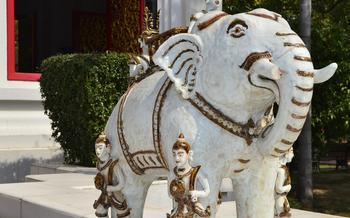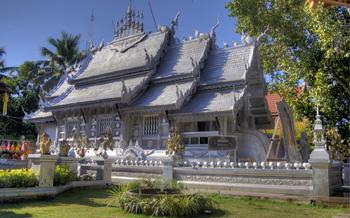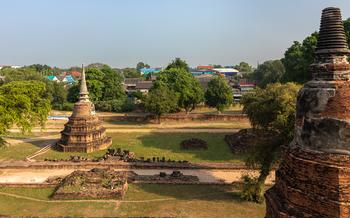
Wat Phra Phutthabat Khao Noi
- Wat Phra Phutthabat Khao Noi: A Sacred Buddhist Temple
- Location and Getting There
- Temple Complex and Architecture
- Giant Footprint of Buddha
- Surrounding Landscape and Scenery
- Entrance Fees and Opening Hours
- Nearby Attractions and Activities
- Accommodation and Dining Options
- Suggested Itinerary for a Day Trip
- Morning:
- Midday:
- Afternoon:
- Cultural Insights and Local Customs
- Festivals and Events
- Responsible Tourism
Wat Phra Phutthabat Khao Noi: A Sacred Buddhist Temple
Wat Phra Phutthabat Khao Noi, known for its giant footprint of Buddha, holds deep historical and religious significance for Thai people. Built in the 14th century, the temple is believed to have been visited by Buddha himself, leaving his footprint as a testament to his presence. The footprint, revered as a sacred relic, draws pilgrims and devotees from across the country, seeking blessings and paying homage to the Lord Buddha.
The temple's unique architecture, intricate carvings, and serene ambiance create a spiritual atmosphere that captivates visitors. It serves as a reminder of the rich cultural heritage and deep devotion that permeates Thai society.
During my visit to Wat Phra Phutthabat Khao Noi, I was struck by the palpable sense of reverence and tranquility that enveloped the temple grounds. The sight of the giant footprint, so intricately carved into the rock, filled me with awe and wonder. I couldn't help but be moved by the devotion of the pilgrims, who offered prayers and made offerings, seeking guidance and blessings from the sacred relic.
Location and Getting There
Wat Phra Phutthabat Khao Noi is situated in the Nakhon Thai District, approximately 25 kilometers southeast of Phitsanulok city center. This revered temple can be conveniently accessed by various means of transportation, offering visitors multiple options to reach their desired destination.
For those seeking a comfortable and scenic journey, renting a car or hiring a private taxi is an excellent choice. This allows for a flexible itinerary and the convenience of traveling at your own pace. Alternatively, public transportation provides a budget-friendly option, with regular buses departing from Phitsanulok's main bus station. The journey by bus takes approximately 45 minutes to an hour, offering a glimpse into the local way of life.
Guided tours are also available for those who prefer a more immersive experience. These tours often include round-trip transportation from Phitsanulok city, allowing visitors to sit back, relax, and absorb the rich history and cultural significance of the temple. Whether you choose to explore independently or embark on a guided tour, planning your journey in advance is always advisable to ensure a smooth and hassle-free experience.
Temple Complex and Architecture
The Wat Phra Phutthabat Khao Noi temple complex is a testament to the architectural prowess of the ancient Thai people. The temple's layout is symmetrical and well-organized, with the main structures arranged along a central axis. The main sanctuary, or viharn, is the largest building in the complex and houses the giant footprint of Buddha. The viharn is adorned with intricate carvings and sculptures depicting scenes from Buddhist mythology.
The temple's architectural style is a blend of traditional Thai and Khmer influences. The roofs of the buildings are steeply pitched and feature intricate gable ends. The columns supporting the roofs are adorned with lotus bud capitals, a common feature in Thai architecture. The temple's overall design is harmonious and balanced, creating a sense of serenity and tranquility.
Symbolism and iconography play an important role in the temple's architecture. The giant footprint of Buddha is the most prominent symbol, representing the Buddha's presence and his teachings. The lotus bud capitals on the columns symbolize purity and enlightenment. The naga, or serpent, motifs found throughout the temple symbolize protection and good luck.
One of the most interesting architectural features of the temple is the "Phra That Khao Noi," a large chedi or stupa located on a hill behind the main temple complex. The chedi is believed to contain relics of the Buddha, and it is a popular pilgrimage site for Thai Buddhists.
Giant Footprint of Buddha
The highlight of Wat Phra Phutthabat Khao Noi is undoubtedly the giant footprint of Buddha, which is the largest and most revered in Thailand. According to legend, the footprint was left by Buddha himself when he visited the site over 2,000 years ago. It is believed that the footprint holds immense spiritual power and brings good fortune to those who pay homage to it.
The footprint is housed in a grand pavilion adorned with intricate carvings and colorful murals. Devotees from all over Thailand and beyond come to pray and meditate before the footprint, seeking blessings for themselves and their loved ones. Many also perform rituals such as lighting candles, offering flowers, and chanting mantras to show their devotion.
In addition to its religious significance, the giant footprint is also a marvel of ancient craftsmanship. The footprint is carved into a solid rock and measures over 2 meters in length. It is perfectly preserved, with intricate details such as the toes, arch, and heel clearly visible. It is truly a testament to the skill and artistry of the ancient Thai artisans who created it.
My visit to the giant footprint was a deeply moving experience. As I stood before it, I felt a sense of awe and reverence. The sight of the footprint brought to life the stories and legends I had heard about Buddha and his teachings. It was a reminder of the power of faith and the enduring legacy of Buddhism in Thailand.
Surrounding Landscape and Scenery
The natural beauty surrounding Wat Phra Phutthabat Khao Noi is as captivating as the temple itself. The temple grounds offer panoramic views of the lush green hills and valleys that characterize the Phitsanulok region. Visitors can take a leisurely stroll or hike through the serene surroundings, immersing themselves in the tranquility of nature. The temple's elevated location provides breathtaking vistas, allowing you to capture stunning photographs of the picturesque landscape. Whether you're seeking a moment of solitude or an invigorating hike, the natural beauty of Wat Phra Phutthabat Khao Noi promises a memorable experience.
Entrance Fees and Opening Hours
Entrance Fees: - Thai citizens: 20 baht per person - Foreign visitors: 50 baht per person
Free Admission: - Children under 12 years old - Monks and novices
Opening Hours: - Daily from 8:00 AM to 5:00 PM
Tips for Avoiding Crowds: - Visit the temple early in the morning to avoid the midday heat and crowds. - If possible, try to avoid visiting on weekends and public holidays, as these are typically busier times. - Consider joining a guided tour to make the most of your visit and learn more about the temple's history and significance.
Nearby Attractions and Activities
Wat Phra Phutthabat Khao Noi is surrounded by various attractions that offer a diverse range of experiences for visitors. For those interested in history and culture, the city of Phitsanulok boasts several ancient temples, including the majestic Wat Phra Sri Rattana Mahathat, renowned for its exquisite Buddha images and intricate murals. The Phitsanulok National Museum houses a collection of historical artifacts and exhibits that shed light on the city's rich past.
Nature enthusiasts will find solace in the picturesque surroundings of the temple. Khao Noi Mountain, where the temple is situated, offers scenic hiking trails that lead to breathtaking viewpoints overlooking the city and the surrounding countryside. For a refreshing swim and a chance to admire the natural beauty of the region, visitors can head to Kaeng Sopha Waterfall, located a short drive from the temple.
Those seeking a taste of local life can explore the vibrant markets of Phitsanulok, where they can browse for souvenirs, sample delicious street food, and interact with friendly locals. The city also offers a variety of shopping malls and modern amenities for those seeking a more contemporary experience.
Accommodation and Dining Options
For a comfortable and convenient stay near Wat Phra Phutthabat Khao Noi, there are several hotels and guesthouses to choose from. Whether you prefer a luxurious retreat or a budget-friendly option, there's something to suit every traveler's needs.
For a truly immersive experience, consider staying at a traditional Thai guesthouse. These guesthouses often offer simple but charming accommodations, allowing you to connect with the local culture and way of life. Alternatively, for those seeking modern amenities and comfort, there are several hotels and resorts in the vicinity that provide a range of facilities and services.
When it comes to dining, there are plenty of local restaurants and food stalls around the temple where you can savor authentic Thai cuisine. Indulge in delicious dishes such as Pad Thai, Khao Soi, and Som Tum, prepared using fresh ingredients and bursting with flavors. Be sure to try the local street food, which is often a great way to experience the culinary delights of the region.
If you're on a budget, there are several affordable options available. Look for food stalls or markets where you can find delicious meals at reasonable prices. These stalls often offer a variety of dishes, allowing you to sample different flavors and specialties.
For a memorable dining experience, consider visiting one of the local restaurants that specialize in traditional Thai cuisine. These restaurants typically offer a more refined dining experience, showcasing the culinary artistry and flavors of the region. Reservations are recommended, especially during peak tourist seasons.
Suggested Itinerary for a Day Trip
If you're planning a day trip to Wat Phra Phutthabat Khao Noi, here's a suggested itinerary to make the most of your visit:
Morning:
- Start your day early to avoid the crowds. Aim to arrive at the temple by 8 am.
- Begin your exploration with the giant footprint of Buddha, paying homage and learning about its significance.
- Stroll through the temple complex, admiring its architectural beauty and serene ambiance.
- Visit the main ordination hall and pay your respects to the Buddha images enshrined within.
Midday:
- Take a break from temple exploration and savor a delicious lunch at one of the local restaurants near the temple. Try authentic Thai dishes like pad thai or khao soi.
- After lunch, visit the museum within the temple complex to learn more about its history and cultural significance.
- If time permits, take a leisurely walk around the temple grounds, enjoying the natural beauty and peaceful surroundings.
Afternoon:
- As the afternoon sun casts a golden glow over the temple, capture stunning photographs of the landscape and architecture.
- If you're feeling adventurous, embark on a short hike in the surrounding hills, offering panoramic views of the temple and the countryside.
- Conclude your day at Wat Phra Phutthabat Khao Noi with a final visit to the giant footprint of Buddha, paying your respects and reflecting on the spiritual significance of your journey.
Remember, this itinerary can be customized based on your interests and time constraints. Whether you're a history buff, a nature lover, or a spiritual seeker, Wat Phra Phutthabat Khao Noi offers a fulfilling and memorable experience for all visitors.
Cultural Insights and Local Customs
Visiting Wat Phra Phutthabat Khao Noi offers a glimpse into the rich cultural tapestry of Thailand and the deep-rooted Buddhist traditions that shape the country's identity. As you explore the temple grounds, you'll encounter various customs and practices that reflect the local culture.
Festivals and Events
Wat Phra Phutthabat Khao Noi plays host to several significant festivals and events throughout the year, attracting a large number of devotees and visitors. One of the most important festivals is Makha Bucha, a Buddhist holiday celebrated on the full moon day of the third lunar month. During this festival, worshippers gather at the temple to make offerings, listen to sermons, and participate in candlelight processions.
Another notable event is Visakha Bucha, which commemorates the birth, enlightenment, and passing of Buddha. The temple organizes special ceremonies, chanting sessions, and meditation courses during this festival. Visitors can also witness the procession of Buddha images around the temple grounds, accompanied by music and dance performances.
In addition, the temple holds a grand Songkran Festival every year, marking the Thai New Year. During this festival, people engage in water-splashing activities, symbolizing the washing away of bad luck and impurities. The temple's courtyard becomes a lively venue for water fights, cultural performances, and traditional games.
Participating in these festivals at Wat Phra Phutthabat Khao Noi offers a unique opportunity to immerse oneself in Thai culture and Buddhist traditions. Visitors can witness the devotion and enthusiasm of the local people and gain a deeper understanding of their beliefs and practices.
Responsible Tourism
As you embark on your journey to Wat Phra Phutthabat Khao Noi, it is essential to embrace the principles of responsible tourism. Remember, this sacred temple holds immense cultural and religious significance for the Thai people. It is our duty as visitors to respect the sanctity of the site and minimize our environmental impact.
First and foremost, dress modestly and behave respectfully within the temple grounds. Refrain from loud noises, and always seek permission before taking photographs, especially if monks or other visitors are present. Additionally, avoid touching any religious artifacts or statues unless explicitly permitted.
Furthermore, be mindful of your carbon footprint by opting for sustainable transportation methods. Consider walking, cycling, or using public transport to reach the temple. If driving is necessary, carpool or choose a fuel-efficient vehicle. Once at the temple, conserve water and energy by taking shorter showers, turning off lights when not in use, and properly disposing of waste.
Embrace the opportunity to support local communities by purchasing souvenirs from local vendors and dining at nearby restaurants. This not only contributes to the local economy but also allows you to experience authentic Thai cuisine and culture.
By practicing responsible tourism, we can help preserve the pristine beauty and sacredness of Wat Phra Phutthabat Khao Noi for generations to come. Let us all be mindful travelers, leaving a positive impact on this cherished destination.




